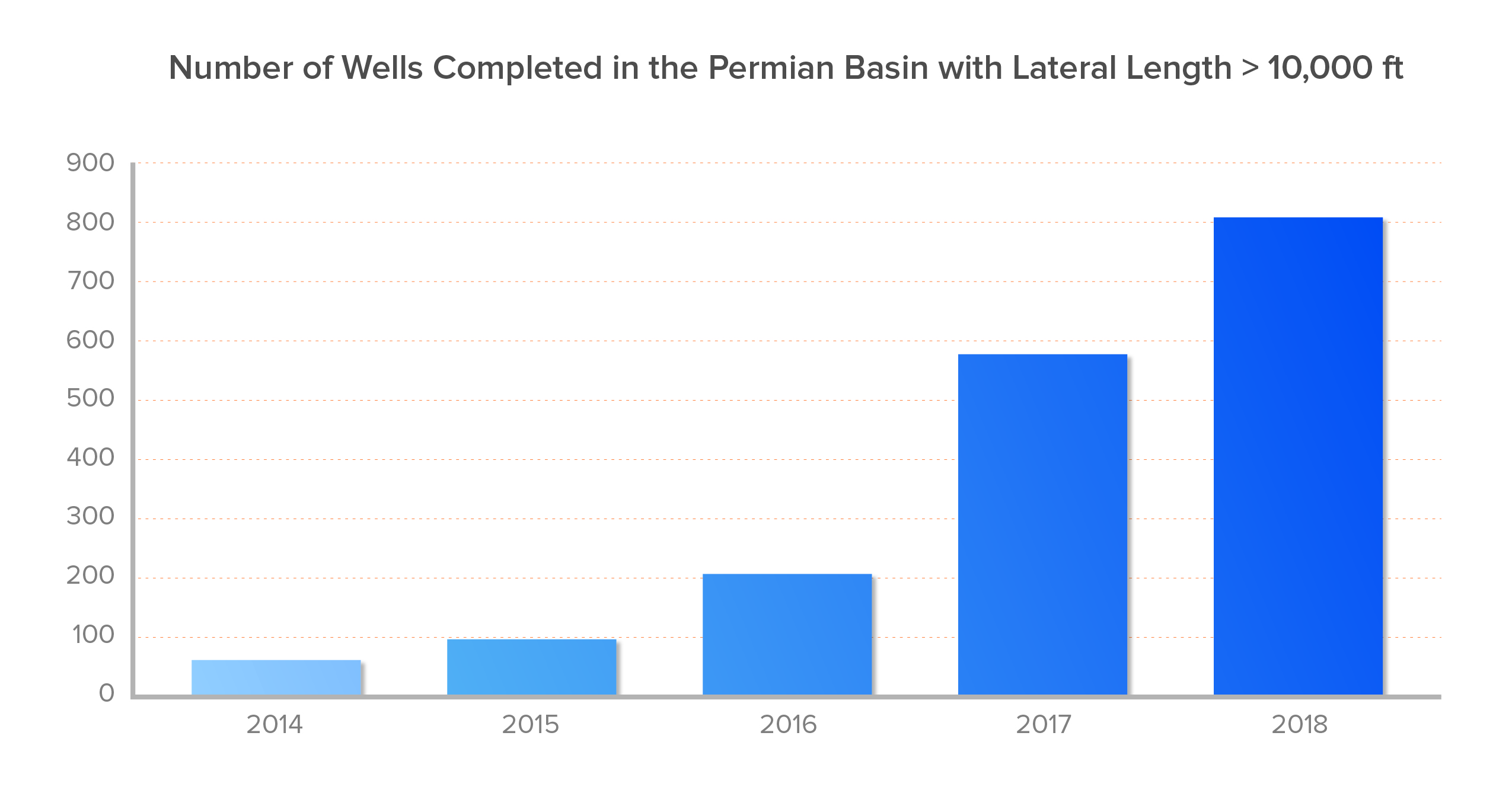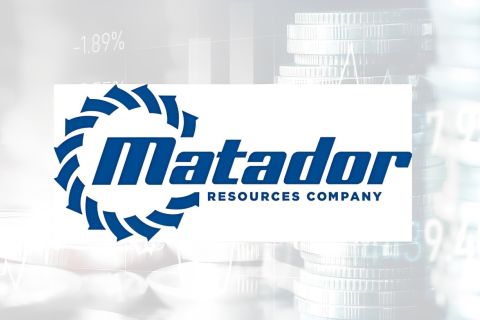
(Source: Hart Energy)
[Editor's note: This story originally appeared in the April 2020 edition of E&P. Subscribe to the magazine here.]
Once somewhat of a novelty, extended-reach laterals are now being drilled at a greater pace across North America. In the Permian Basin, for example, the number of horizontal wells completed with lateral lengths exceeding 10,000 ft has increased by nearly 12 times over the last five years, jumping from 63 in 2014 to
813 in 2018.
These longer laterals have provided operators with the ability to complete more stages and achieve greater reservoir coverage with every well, resulting in higher production per well. Yet, it has not come without challenges.
One challenge is effective stimulation at the toe stages of the well. Operational challenges and risk arise when using tubing-conveyed perforating for the first stage of completion operations. This risk is present by the nature of the extreme distance the tools must travel downhole. Although hydraulically activated sliding sleeves were introduced to solve this challenge, reliability has been an issue, and many operators have been forced to run multiple sleeves as a precautionary measure.
Packers Plus released a suite of tools to run at the toe of extended-reach laterals that address current challenges by decreasing risk with interventionless operation. Combining these toe options with sliding sleeve completion technology can further expedite completion time and bring wells online quicker.

Stimulation challenges
Plug and perf (PNP) is by far one of the oldest completion methods. This method predates horizontal wells and, as such, the wireline deployed in vertical or slightly deviated wells relied on gravity for downhole conveyance. In horizontal wells, large volumes of water are needed to pump wireline perforating guns to depth, especially if there are doglegs and tight areas. If for any reason the tools get stuck, remedial mechanical or hydraulic tools require additional fluid.
PNP tools also can be deployed using coiled tubing (CT). One advantage of using CT for the toe stages is the ability to continually circulate fluid, which helps condition the well for smoother conveyance. However, a significant disadvantage of CT is its reach. Energized fluid, specialized metal-to-metal lubricants and tractors or agitators can help with the conveyance. However, CT can spiral due to cumulative friction when pushing tools to depth. If CT is pushed too hard, it can kink or buckle, causing the tubing to become stuck or part. For long wells, these restrictions may leave the toe stages out of reach of CT.
Hydraulically activated sleeves
Hydraulically activated sliding sleeves eliminate the need for intervention for the first stage of a completion program, which is a major benefit in extended-reach lateral wells. These sleeves are opened hydraulically, without the need for intervention and initiate fluid flow into the reservoir to initiate stimulation.
Reliability has become a common issue regarding some hydraulically activated sliding sleeves on the market. Due to some sleeves not opening, operators have taken to running two or three hydraulically activated sliding sleeves at the toe of a well to ensure at least one sleeve will provide access to the reservoir. While this option does allow interventionless operations, it is not a cost-effective solution.
Stimulation options
Packers Plus has engineered systems to effectively stimulate the toe stages of extended-reach laterals through a suite of hydraulically activated toe subs: the Toe-XT Testable Hydraulic Toe Sleeve, Toe-AP Hydraulic Toe Sleeve, TREX Rupture Disc Sub and TREX Wet Shoe Sub.
The Toe-XT Testable Hydraulic Sleeve is an injection/production port that allows the casing string to be pressure tested a single time before opening. After the casing integrity test has been performed and pressure in the well is released, the sliding sleeve is ready for activation and the operator can begin stimulation operations.
The Toe-AP Hydraulic Toe Sleeve is a sliding sleeve for the first stage of a cemented liner that reduces operational risk, while saving time and cost in delivering an effective treatment of the first stage. The reliability of the toe sleeve is enhanced by incorporating an internal rupture disc for tool activation.
The TREX Rupture Disc Sub eliminates the need for a CT run to perforate the first stage in PNP completions. This hydraulically activated sub is typically run as an economical backup option to the primary hydraulic toe sleeve. If required, the rupture discs will burst at a set pressure to establish communication with the reservoir and enable wireline tools to be deployed to stimulate the first stage.
The TREX Wet Shoe Sub is a hydraulically activated tool that eliminates the need for a CT run to perforate the first stage in PNP completions. Assembled just above the float collar, the landing dart that displaces cement is used to activate the Wet Shoe Sub and create a flow path around the dart to establish communication with the reservoir and enables wireline tools to be deployed to commence stimulation operations.
With a range of functionalities, hydraulic toe subs can be incorporated into a variety of completion designs to reduce operational risk in stimulating the first stage of a horizontal well.
Hybrid completion systems
Combining hydraulically activated toe subs with sliding sleeve technology in the lower stages of an extended-reach lateral well can further enhance the operational efficiency experienced for the first stage. Hybrid completions have become particularly useful in extended-reach lateral wells.
Ball-activated completions are ideal for lower stages, as they do not require conveyance by CT or wireline. Packers Plus ball-activated systems give operators the flexibility needed for hybrid systems in openhole or cemented liners as well as single-point entry or limited-entry applications. Ball-activated sleeves in the toe of extended-reach laterals help start the treatment process faster and more efficiently than traditional PNP methods.
A crossover back to PNP or CT sleeves is typical for systems at the point when measured depths for upper stages are within easy reach. The hybrid combination is customizable to suit operator preferences and completion design requirements, enabling a customized system that utilizes the best features of each technology.
Case studies
An operator working in the Permian Basin installed the Toe-XT Hydraulic Sleeve to simplify operations for the first stage of a PNP well. After nearly eight months sitting downhole, activation of the toe sleeve was successfully executed without issue.
A casing integrity test to 8,900 psi was performed for 15 minutes before the Toe-XT Hydraulic Sleeve was activated for stimulation. The sleeve opened on the next pressure cycle, enabling stimulation of the first stage. The second stage of the well included five QuickPORT IV Limited Entry Sliding Sleeves, which enabled operations to continue without downtime between stages.
In another case, an operator working in the Permian Basin successfully resolved operational issues in extended-reach laterals by deploying ball-activated sliding sleeves for the toe stages of its PNP completions.
One of the wells included 80 QuickPORT IV Limited Entry Sliding Sleeves segmented into 20 stages to cover the deepest 3,900 ft of the lateral before reverting back to PNP for the rest of the well. This hybrid completion technique proved effective, and all 20 stages were stimulated in less than 70 hours of pumping time.
Conclusion
Hydraulically activated toe subs provide an effective and efficient method for beginning stimulation operations in extended-reach laterals. By deploying these tools at the toe of a well, operators are able to reduce operational risk associated with the conveyance of wireline or CT in extended-reach laterals and effectively stimulate the toe stage while minimizing nonproductive time and expediting completion time to bring wells online faster.
Recommended Reading
Matador Stock Offering to Pay for New Permian A&D—Analyst
2024-03-26 - Matador Resources is offering more than 5 million shares of stock for proceeds of $347 million to pay for newly disclosed transactions in Texas and New Mexico.
Kimmeridge Fast Forwards on SilverBow with Takeover Bid
2024-03-13 - Investment firm Kimmeridge Energy Management, which first asked for additional SilverBow Resources board seats, has followed up with a buyout offer. A deal would make a nearly 1 Bcfe/d Eagle Ford pureplay.
Laredo Oil Subsidiary, Erehwon Enter Into Drilling Agreement with Texakoma
2024-03-14 - The agreement with Lustre Oil and Erehwon Oil & Gas would allow Texakoma to participate in the development of 7,375 net acres of mineral rights in Valley County, Montana.
Hess Corp. Boosts Bakken Output, Drilling Ahead of Chevron Merger
2024-01-31 - Hess Corp. increased its drilling activity and output from the Bakken play of North Dakota during the fourth quarter, the E&P reported in its latest earnings.
The OGInterview: Petrie Partners a Big Deal Among Investment Banks
2024-02-01 - In this OGInterview, Hart Energy's Chris Mathews sat down with Petrie Partners—perhaps not the biggest or flashiest investment bank around, but after over two decades, the firm has been around the block more than most.





